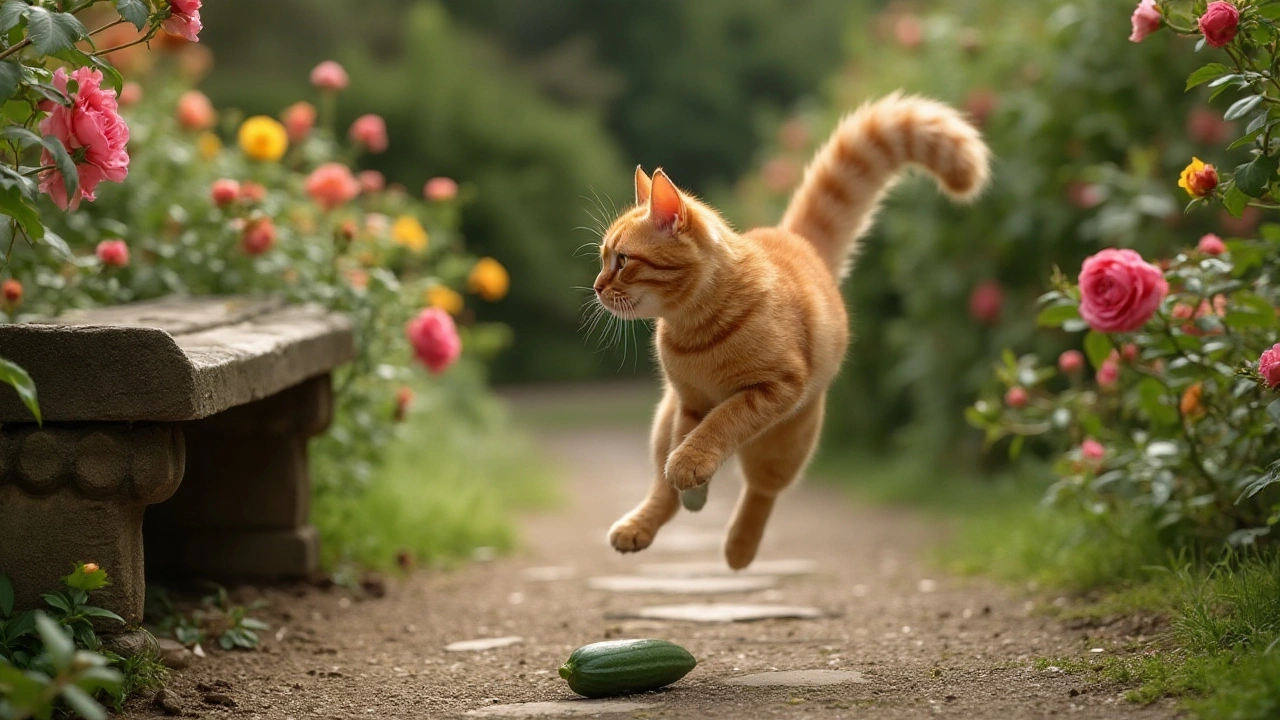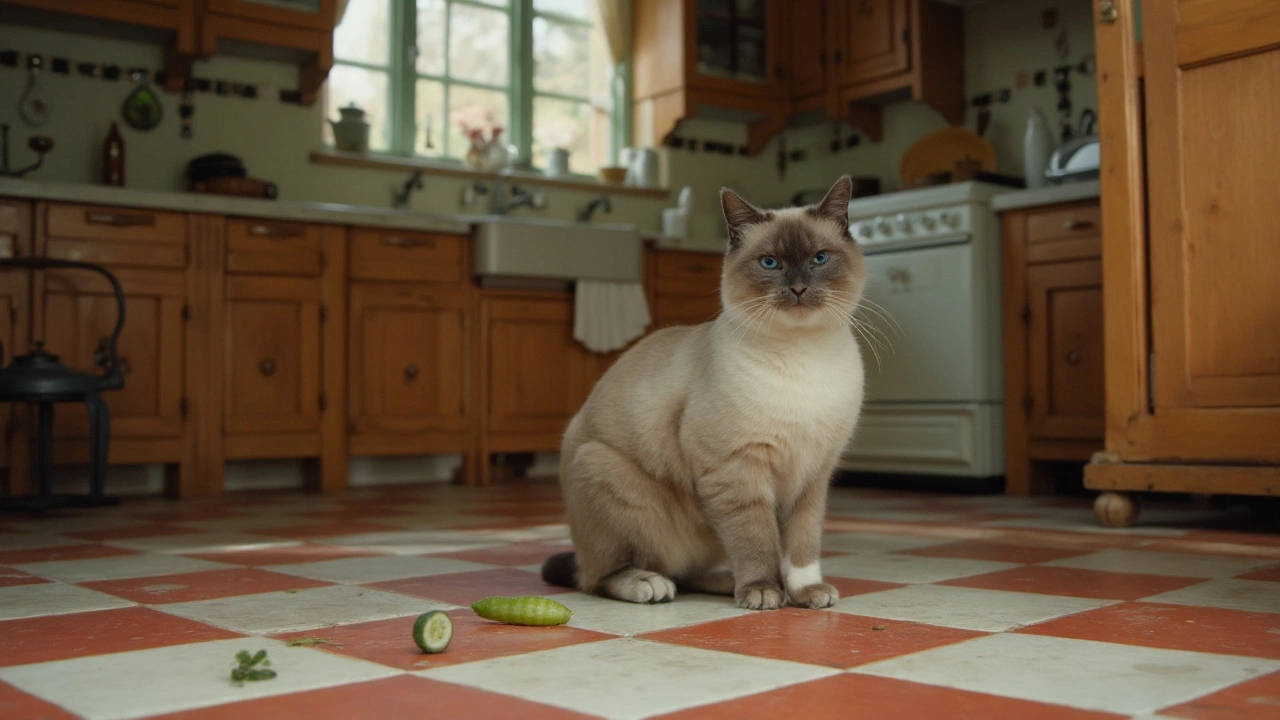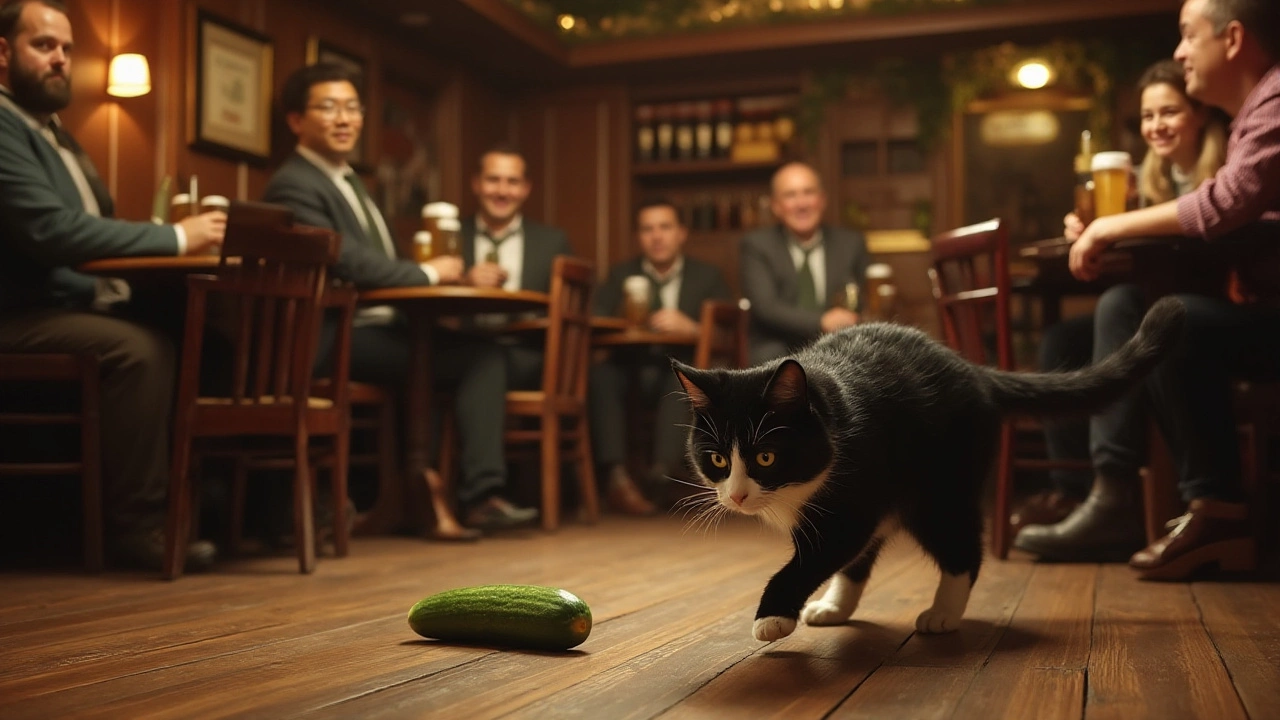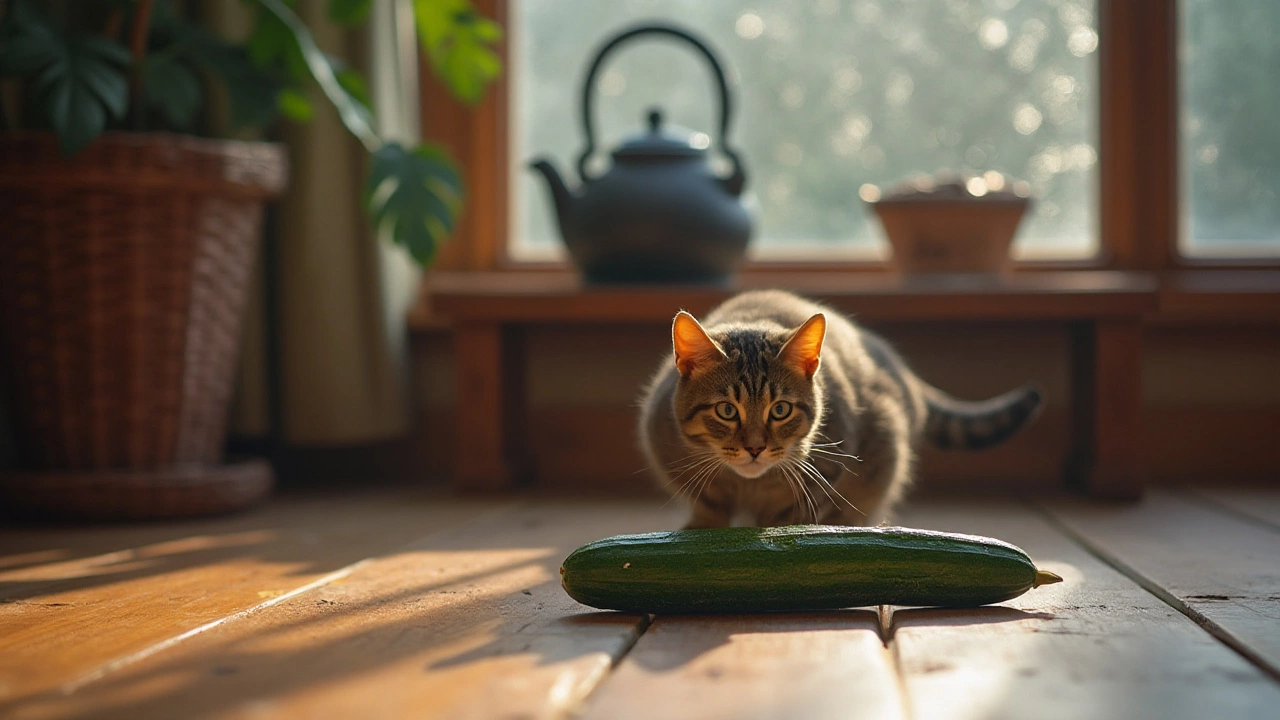It's a question that has puzzled pet owners and amused internet users alike—why do cats seem to react with such alarm to cucumbers? This curious phenomenon, often capturing online attention through viral videos, showcases cats leaping sky-high or darting away at the sight of this harmless vegetable. But what exactly causes this dramatic reaction?
The answer lies partly in the way cats perceive their environment. Cats have a finely tuned startle reflex, which is crucial for survival in the wild. An unfamiliar object suddenly appearing can be perceived as a threat, akin to a predator sneaking up on them. Placing a cucumber behind a cat when it is not looking can trigger this innate reaction.
Understanding why cats respond to certain stimuli in surprising ways can help pet owners create a more comforting space for their furry friends. It's not just cucumbers—certain shapes or surprises in their environment can also startle them. This knowledge allows guardians to cater better to their pet's needs, ensuring their environment is both enriching and reassuring.
- The Mystery of Cats and Cucumbers
- Understanding Feline Reactions
- Implications for Cat Food Choices
- Tips to Prevent Startle Responses
The Mystery of Cats and Cucumbers
Why do seemingly everyday objects like a cucumber send our feline friends into a frenzy of fright? This peculiar behavior has left many of us scratching our heads, watching our otherwise brave cats leap for dear life at the mere glimpse of this innocuous green vegetable. The root of this hysteria is embedded deep within the cat's survival instincts, honed over millennia. In their natural habitats, cats must always be on high alert for potential predators, and anything unexpected in their visual field can trigger an immediate, intense fight-or-flight response. This survival mechanism, while beneficial in the wild, can lead to some of the startled antics we observe at home.
When a cucumber suddenly appears behind a cat as it's eating or distracted, it taps into their intrinsic fear of snakes—a natural enemy throughout their evolutionary history. The elongated, slender shape of a cucumber, especially when placed stealthily, mimics the form of a snake, prompting the cat to leap into action, quite literally. This is not to say every cat will respond this way, as factors like individual personality, previous experiences, and even the specific context play a significant role in determining their response.
Desmond Morris, a renowned zoologist, once observed, "For cats, the presence of anything unexpected or suddenly appearing could be potentially dangerous, triggering evolutionary ingrained reflexes designed to keep them safe."However compelling this theory sounds, not all experts completely agree. Some suggest that the fright is more a startle than a deep-seated phobia, with the abrupt appearance being the main cause of the reaction. It's important to note that while these reactions often seem amusing, they might not be in the best interest of the cats. Repeated exposure to unexpected stimuli can lead to stress, anxiety, and distrust, emphasizing the need to understand and respect these intricately wired creatures.
Meanwhile, our digital era hastened the spread of such behaviors across social platforms, turning the reaction into an odd entertainment form. While it's hard to resist posting such a video, it's crucial to consider the wellbeing of our pets. With this awareness, we can appreciate the humor while also driving more nurturing discussions about cat behavior and care. Understanding this phenomenon isn't just about appreciating a funny moment; it's a peek into the profound complexity of feline minds.

Understanding Feline Reactions
Cats are known for their acute senses and swift reactions, which are evolutionary adaptations that have served them well as both predators and prey. When we consider why cats might jump or dash away from a vegetable like a cucumber, it's essential to explore how these instincts play a crucial role in their behavior. Most cats will react strongly to sudden changes in their environment, possibly due to their heightened startle reflex. This reflex, a rapid-response system that bypasses usual conscious processing, is a survival mechanism developed to protect them from potential threats.
Although the feline brain does not interpret a cucumber as a direct threat, the surprise factor alone—combined with its silhouette (which might resemble a snake, a common predator of cats)—can provoke an alarming response. This reaction is less about the specific object and more about the environment suddenly harboring an unknown factor. According to animal behaviorists like Dr. Roger Mugford, as quoted in a well-known study on pet psychology, "Cats often see sudden intrusions as potentially harmful until proven otherwise." The strong tonality of Dr. Mugford’s analysis illustrates that sudden encounters with unfamiliar objects, not limited to cucumbers, can heighten a cat’s defensive instincts.
Understanding this reflex is vital for pet owners who aim to provide a safe, stress-free environment for their pets. In addition to cucumbers, other innocuous items like artificial plants, rubber toys, or even a hastily tossed jacket can elicit similar startle responses. The visual acuity of cats is another factor; they perceive movement better than stationary objects, which contributes to their surprise when an originally unseen item suddenly appears in their field of vision. This acute sense of sight is complemented by their keen hearing, allowing them to detect subtle changes in acoustics—a rustle, a drop, a vibration—which adds layers to their perception of immediate threats.
Reacting to Unfamiliar Objects
Cats not only rely on their vision but also depend heavily on their olfactory senses. The presence of a new object may also bring new smells into their perception range, which their sensitive noses are quick to explore or sometimes ignore if associated with something unexpected and startling. Understanding how much our beloved cats mistrust novelty helps us mitigate potential causes of stress. Pet owners can use these insights to reduce startle reactions, perhaps by gradually introducing unfamiliar items alongside known, comforting smells and textures. Knowing these facts equips cat caretakers to better predict how new environments or items will impact their felines’ composure.
This nuanced comprehension of cat behavior is underpinned by numerous studies into animal psychology and sensory perception. Favorably positioned within a calm, predictable environment, a cat's response to new stimuli will largely depend on their past experiences and overall bravery. Ensuring that these stimuli remain consistent and gradually introduced can significantly reduce episodes of startling, leading to an improved quality of life for our furry companions.

Implications for Cat Food Choices
The curious reaction of cats towards cucumbers not only amuses us but also holds insights on what to consider while choosing the right food for your feline friends. Cats are creatures of instinct, and this means their environment and diet play a critical role in their well-being. While cucumbers themselves aren't toxic to cats, their unexpected appearance can trigger a fear response that reflects a deeper sensitivity to changes in their diet and surroundings.
When we talk about food choices for cats, understanding their natural diet is crucial. In the wild, cats are obligate carnivores, meaning their diet primarily consists of meat. This influences their need for specific nutrients like taurine, arachidonic acid, and certain vitamins that are naturally present in prey animals. These essential nutrients are often not found in plant-based foods like cucumbers, which suggests why a sudden new item can be alarming. The fear of cucumbers isn't directly linked to diet, but it emphasizes how startling unfamiliar elements can be for them.
What to Consider in Cat Foods
When selecting food for cats, it’s important to ensure it is high in protein and provides the necessary nutrients for their development and health. Many commercial cat foods are designed with their dietary needs in mind, balancing protein with essential fats and high-quality carbohydrate sources. However, some pet owners explore raw feeding, which mimics the natural diet of wild cats. One must be cautious with homemade or raw diets since they require careful formulation to avoid nutritional deficiencies.
“Understanding what ingredients work best for your cat isn't just about nutrition; it's about knowing the feline psyche,” says Dr. Susan Nelson, clinical veterinarian.
Sensitivity to foods and unexpected items like cucumbers can serve as a reminder that changes in diet or the introduction of new foods should be gradual and observed for adverse reactions. With the increasing trend in hypoallergenic and specialty diets, it's critical to tailor food choices to individual preferences and tolerances. Observing how your cat interacts with its environment can give clues to what it might enjoy or fear in its diet, giving us insight beyond just nutrition.

Tips to Prevent Startle Responses
Creating a harmonious and safe environment for your feline companion isn’t just about love and affection; it's about understanding their nature and adapting our spaces to better suit their needs. Many cats startle easily due to their heightened senses, which are hardwired from their days as both predators and prey in the wild. This means being aware of sudden stimuli that might cause unnecessary stress, like unexpectedly placed objects or loud noises.
One of the fundamental strategies for minimizing startle responses in cats is to maintain a stable environment. Cats thrive on routine and predictability, so keeping their space consistent can minimize anxiety. Regularly rearranging your home or introducing new pets or furniture can unsettle your kitty. If changes are necessary, try to do them gradually, allowing your pet to sniff and explore new items at their own pace.
It's also invaluable to engage in positive reinforcement when your cat encounters potentially startling situations. For example, if they react calmly to a new object or sound, reward them with treats or affection. This can help to condition them to react less fearfully. Moreover, enriching their environment with safe toys and structures can help divert focus from other less friendly stimuli. A properly enriched environment can increase a cat’s feeling of security and decrease the likelihood of a startle reaction.
Limit Unintentional Surprises
Human activities can often unintentionally startle cats. This includes dropping items, closing doors abruptly, or raising your voice. Observe your habits and make conscious efforts to be gentle around your feline friend. When introducing new objects such as furniture or decorations, allow your cat time to adjust. By gently bringing a new cushion or toy into their space, the cat can acquaint itself without a rush.
According to renowned veterinarian Dr. Patricia Thompson, "A cat's inherent nature is to stay vigilant due to their unpredictable environments in the wild. Respecting this aspect by carefully managing their home settings reduces stress significantly."
Minimizing the presence of other startling stimuli, whether it's through dulling sharp noises or avoiding abrupt temperature changes, will help your pet feel more at home. Such steps ensure the affectionate and serene relationship between you and your beloved pet flourishes without the hurdles of sudden frights.
